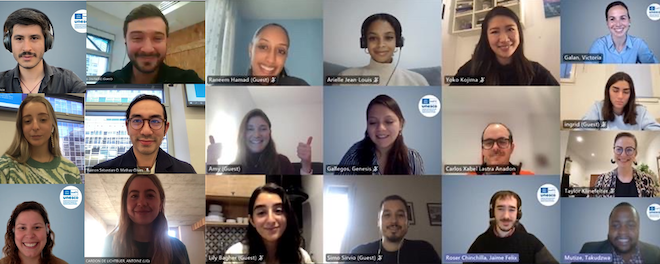The transformation of higher education

Essays on educational transformation tend to be divided into two groups: those that bet on a messianic vision and those that bet on an exacerbated pessimism. The former tends to be grandiloquent, with language that veers between epic and poetic and tends to leave the reader dumbfounded but without a clear idea of how to move forward or what to start doing today. The latter, on the other hand, plunges the reader into a state of acceptance of the umpteenth inevitable misfortune that looms over our young generations. It is possible that these two approaches are, in a way, complementary and that the reading of texts or the viewing of talks alternating between the two is a way of promoting progress and reflection in a dialectical process.
This contribution has opted for an approach to the transformation of higher education that attempts to describe and analyse trends of which we are just beginning to have signs. This may run the risk of erring on the side of conservatism or perhaps simply incrementalism. But what is certain is that the end of the pandemic seems to have clearly demonstrated that, far from radical changes, higher education is much more inclined to continuity than to radical change, moderated as it is by its proverbial capacity to absorb threats and digest opportunities. Higher education changes, yes, but always preserving the continuity of those elements that the academic community itself considers essential and that continue to attract students, at least for the time being.
There are, in this sense, three changes that once again suggest a progressive evolution: in student profiles, partly derived from demographic dynamics; in the configuration of higher education provision, both in its modalities and in the nature of the programs; and finally, in pedagogical methodologies.
The traditional perspective on higher education is that its educational offerings pre-exist the students and that they must strive to meet the proverbial academic requirements. Accordingly, and given the value that society and the labour market place on credentials obtained in higher education, the important thing would be to remain faithful to the selective and meritocratic character that has so far guaranteed a good return on investment for those who graduate.
In Latin America and the Caribbean, the phenomenon of the explosion of demand that resulted in a quasi-anarchic supply growth with a notable absence of government regulation is well known. Over time, a process of progressive consolidation of demand has been generated, thanks to the actions of quality assurance agencies and governments. But now that a better balance seems to have been achieved, there are signs that young people’s demand for higher education is receding, even where governments are making significant efforts to improve equity in access and inclusion.
The reasons for this decline are manifold. The first and most evident is the reduction in the volume of young people not compensated by the improvement in secondary graduation rates: the percentage of young people graduating from secondary school continues to grow, but the universe of young people is shrinking for demographic reasons. This reduction will tend to accelerate in the 2030 horizon and even more so in 2050.
The second reason is the price-value ratio of higher education. If the pandemic has weakened the purchasing power of middle and lower class families, it has also accelerated the perception that what is on offer does not seem to guarantee a return on investment as attractive as it did years ago, or that this return is deferred over the long term. Low-cost offerings are concentrated in degrees where there is already significant saturation. And training alternatives, such as vocational and technical training programs of shorter duration and price, and even shorter programs, seem to offer them better employment options. Bread for today, hunger for tomorrow?
A second change is related to the modalities of provision and the nature of higher education offerings, particularly in a lifelong education horizon. Higher education institutions are beginning to see that there is a majority population group whose needs for developing skills for life and work have not been adequately addressed. They represent a public with specific needs and characteristics that translate into a demand for greater flexibility: in the modalities of provision, where virtual education is the queen; in the mechanisms of access, where the key lies in the recognition of non-formalised training itineraries, for example, based on work experience; and finally, in the contents of the programs and their duration, in a horizon closer to short-term utilitarianism, as, for example, is usually reflected in micro-credentials.
The inevitable question is whether or not greater attention to adult education will become a strategy that will make it possible to compensate for the decline in demand from young people and, at the same time, whether it will become a real expression of institutions’ commitment to lifelong education. In Latin America and the Caribbean, it is difficult to imagine an educational strategy for the future that does not contemplate the development of lifelong education policies with a leading role for higher education institutions.
The third change is methodological. Since the late 19th century, there have been recurrent calls to reconsider the prevailing model of higher education provision, given its inadequacies in the face of changing social and economic demands and expectations. Especially during the pandemic, newspaper articles, television broadcasts and a great deal of chatter on social media have been showing growing agreement on the importance of changing the paradigm that remains globally predominant – and will most likely remain so as the appearance of radical transformation brought about by the epidemic already begins to fade. The idea that, had we not inherited higher education as it is, our current views on education would drive us to build a vastly different system is already a certainty.
Many discussions of higher education start from the assumption that the reality of the student learning experience is truffled by highly innovative methods. However, it is difficult to find empirical evidence on how teaching is being delivered in university classrooms. Two examples demonstrate that the most commonly used teaching method, the lecture class, hardly conforms to the rhetoric of innovation that often populates discourses on higher education. The first example comes from a review of the main pedagogical strategies used in the business administration programs of more than 200 European universities. In that area, where the development of practical management skills and competencies is so important, it is difficult to understand why the most commonly used method is still the lecture, as opposed to problem-solving or case study work – while a good lecture can be inspiring and compelling, it is not appropriate for the development of skills that promote agency and self-regulation, whereas a practical approach might be much more appropriate. A second example comes from analysing the evolution of teaching strategies in economics programs in U.S. colleges and universities over the past two decades.
Once again, expectations are disappointed by the facts: the most commonly used teaching strategy is the lecture. Moreover, an examination of the evolution of teaching strategies over the past two decades shows that the lecture has remained the most widely used method, increasingly supported by computer-based presentations. The latter have increased at twice the rate of strategies that could easily be linked to more interactive or learner-centred strategies, such as cooperative learning or student discussions.
This evidence shows, for sure, that technology has an undeniable impact in higher education, but the predominant uses tend to reinforce traditional strategies. The problem is not one of availability of resources or applications but of lack of mechanisms and incentives for pedagogical redesign, some of which could be enhanced by intensive use of technology to be considered a priority by teachers. It is more of a systemic problem than a technical one.
The post-pandemic paradox of university pedagogy is that there is a call to rediscover the intrinsic value of interpersonal contact on campus, particularly in the case of young students, and at the same time, a demand for methodological flexibility. Indeed, in the case of young people, there is no doubt about the pernicious effect that the absence of face-to-face contact has had on their personal development. For people who are of an age to benefit enormously from peer socialisation processes, the pandemic represented an accumulation of lost opportunities that have generally resulted in significant damage in the socioemotional field.
Unsurprisingly, many higher education institutions are rushing to expand student assistance services, incorporating precisely those vectors that remind us of the importance of interpersonal growth while in college. In short, it is yet another reminder that, for young people, higher education is not only a mechanism for learning or transit to a skilled labour market but, above all, a transformative life experience.
In this context, technology and, more generally, pedagogical change can be important if they contribute to reinforcing the value of interpersonal exchange. For example, a problem- or project-based pedagogy favours peer-to-peer learning while requiring a radical redesign of the teacher’s role. In this context, technological solutions can help facilitate a multitude of processes. But what cannot be done is suppressing the value of interpersonal exchange for the sake of further process optimisation.
Instead, in the case of adult learners, particularly those who are working, technology can be the platform through which flexibility is promoted. For this reason, it is also not surprising that there are many higher education institutions, starting with business and government schools, with a major shift towards the predominance of distance and hybrid education programs.
Not only is this hybridisation, in the more classical sense of the term, a combination of presence and virtuality, but it also translates into the emergence of much more costly but, at the same time, much more promising formulas such as Hyflex. And this is the paradox: the solutions that seem most appropriate for attracting adult students are not necessarily the ones best suited to the interpersonal growth needs of young students. Consequently, universities need to invest much more in creating teaching support mechanisms to diversify the nature of teaching strategies, aided by a good dose of empirical research to help discern what works well and why from what may be pernicious or counterproductive.
In sum, research insistently reminds us that, since the beginning of the 19th century, educational innovations have been constant, almost overwhelming at times. Still, despite this, formal higher education continues to look alike all over the world because the underlying model is universal.
Some analysts have gone so far as to claim that, despite everything, higher education has progressively changed in its internal structure, the configuration of procedures and the use of technology. However, it does not appear that the universal model of higher education has undergone a transformation.
In a way, the paradox is that the more things have changed on the surface of higher education institutions, the stronger the classical universal model has become. Should we conclude, then, once again, that in education plus ça change, plus ça reste la même chose1? Perhaps, but the important thing is that higher education should not lose sight of the fact that one of its missions is to meet the needs of people who see in it a hope for personal and social development. Placing people at the centre of its educational mission is the best bet for transformation that it can make.
By Francesc Pedró , director of UNESCO IESALC
1 the more it changes, the more it stays the same
RELATED ITEMS








